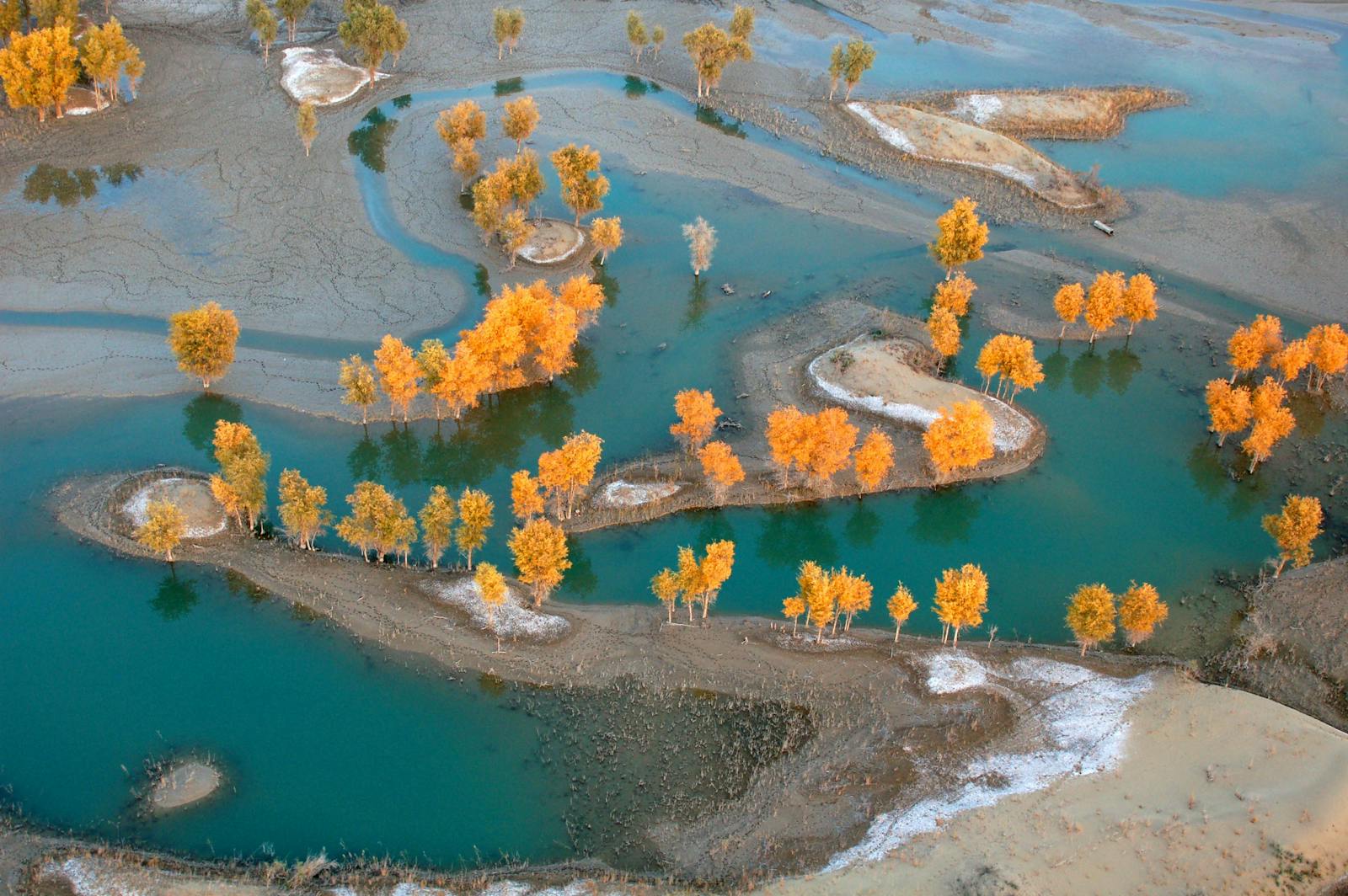Tarim Basin Deciduous Forests and Steppe
The ecoregion’s land area is provided in units of 1,000 hectares. The conservation target is the Global Safety Net (GSN1) area for the given ecoregion. The protection level indicates the percentage of the GSN goal that is currently protected on a scale of 0-10. N/A means data is not available at this time.
Bioregion: Taklimakan Desert & Lowland Deciduous Forests (PA39)
Realm: Eastern Eurasia
Ecoregion Size (1000 ha):
5,460
Ecoregion ID:
684
Conservation Target:
29%
Protection Level:
3
States: China
Situated across Xinjiang, China, the Tarim Basin is further from the ocean than any other place in the world, with high mountains blocking both the Asian monsoon and westerly winter storms. Consequently, the Tarim Basin is the driest place in China, with less than 80 mm precipitation a year at the margins and only 10 mm in the center.
Most of the Tarim Basin is incorporated into the Taklamakan Desert, which is practically devoid of vegetation. However, streams that descend into the Tarim Basin from the Pamir Highlands and the northern margin of the Tibet Plateau form the Tarim River, a broad riparian corridor that extends more than 1,500 km across the desert. Evaporating continuously, even as it gains additional water from the south slope of the Tian Shan Mountains, the Tarim River finally vanishes in the dry, saline basin of Lop Nor.
.jpg)
The flagship species of the Tarim Basin Deciduous Forests and Steppe ecoregion is the Xinjiang ground jay. Image credit: Courtesy of Kennywell, iNaturalist
The riparian corridor of the Tarim River supports a woodland habitat of huyang, or desert poplar, that stabilizes the soil, moderates the climate, and comprises a distinct ecoregion, the Tarim Basin Deciduous Forests snd Steppe. While an estimated 2,000 km2 of poplar forest remains in the Tarim Basin, much of this habitat has been irrigated and converted to agriculture, with the native poplars planted as windbreaks around villages and agricultural fields.
Other tree species of the Tarim Basin Deciduous Forests and Steppe ecoregion are Siberian elm, tamarisk, and Populus pruinosa, a poplar species restricted to places upriver where the soil is not saline. Desert shrubs like Ephedra przewalskii (related to Mormon tea of Western North America), salt-tolerant Zygophyllum xanthoxylum, and the sand-stabilizing Nitraria sphaerocarpa grow farther away from the riparian corridor. Being landlocked, the Tarim Basin can lose water only to evaporation, so salt accumulates in the lower parts of the drainage, creating habitat suitable for the salt tolerant reed, Phragmites australis.
Two restricted-range bird species are reported from the Tarim Basin deciduous forests: Xinjiang ground jay and Vaurie’s nightjar. The former is a bird of sandy desert where poplar and tamarisk grow on stabilized dunes. The latter species is known only from a single individual collected in the southeast part of the ecoregion in 1929, so its status is remains uncertain, but if it is valid and not extinct, it will be a species of great importance to conservation.
Tarim Huyang Nature Reserve (3,954 km2) protects some of the largest remaining stands of desert poplar. The leaves of this species are unusual for a poplar, as their margins vary in outline from blade shaped to deeply lobed like those of a maple. This tree propagates easily, grows quickly, and can attain 30 m in height with a trunk diameter that may exceed one meter. Its adventitious habit and rapid growth aid reproductive fitness in a regime of shifting river channels where water is an ephemeral resource, unpredictable in space and time.
Desert poplar appears nearly impervious to all the various components of environmental harshness that characterize this ecoregion: heat, cold, drought, high winds, and soils that can be sandy, salty or alkaline. Studies have shown that in a particular locale, an individual Huyang poplar will adjust its leaf shape to optimize photosynthesis according to water availability.
Much of the desert popular woodland has been cleared and converted to agriculture; in some areas, salty soils have been irrigated with mountain runoff and are now farmed productively. This trend toward agricultural development is likely to persist as Han Chinese from more densely populated parts of China continue to migrate to China’s western frontier. Agricultural diversion of runoff water from the surrounding mountains can threaten critical poplar habitat, and the alkaline deposits that form when source water is diverted can produce harmful airborne particulates. The Tarim Basin holds extensive petroleum reserves; their exploitation entails additional risks to the environment.
Priority conservation actions for the next decade are to: 1) improve the scope and management of the region’s protected area network; 2) sustain desert poplar woodland habitat by allocating sufficient water and considering appropriate levels of public access; and 3) evaluate status and conservation needs of the two restricted range bird species, Xinjiang Ground-jay, and Vaurie’s Nightjar.
Citations
Carpenter, C. 2000. Tarim Basin deciduous forests and steppe (abstract only). https://globalspecies.org/ecoregions/display/PA0442. Accessed April 2019.
Lu, J. 1995. Ecological significance and classification of Chiense wetlands. Vegetatio 118: 49-56.
Thomas, F.M., Yu, R., Schäfer, P., Zhang. X., Lang, P. 2017. How diverse are Populus “diversifolia” leaves? Linking leaf morphology to ecophysiological and stand variables along water supply and salinity gradients. Flora: 233: 68-78.



